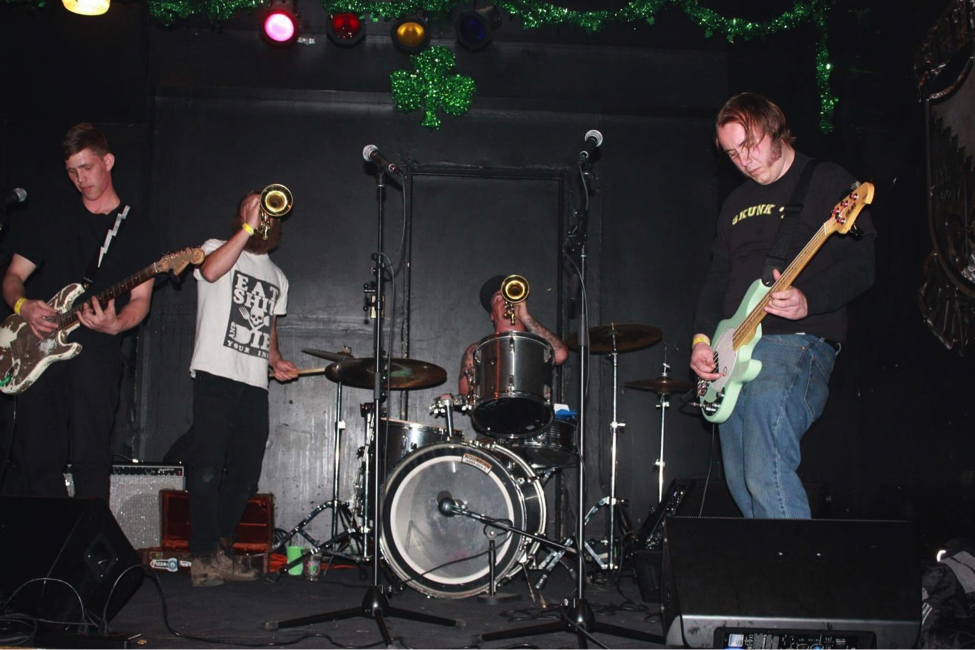

RENO, Midtown –The crowd at Shea’s Tavern is entertained by local rock band Grimedog, a band whose Facebook page simply states, “Sexual is as sexual does.” The relatively new band kicks off a show for Acid Teeth and Vampirates.
One year ago, four young men with different musical backgrounds came together with the common goal of taking their accumulated musical talents to the next level and created Grimedog.
The members of the 4-piece rock band areknown only by their stage names, the Brothers Grimes. Lead singer B.H., or Bastard Hound, Grimes rocks both the microphone and a mountain man beard. Drummer Spanky Grimes plays shirtless. Guitarist Wolfman Grimes sports muttonchops and medium-long hair. Lucas Grimes stands out as the only clean-cut individual of the group.
The audience at Shea’s Tavern is mostly people in their thirties and older, who by appearances identify with the punk/metal scene themselves. You won’t find a suit in a place like Shea’s Tavern. Most of the audience is adorned with weathered band T-shirts, assorted tattoos and body modifications, and dyed, often unkempt hair.
The crowd cheers on Wolfman Grimes as he gulps down a 16-ounce glass of beer with one hand, while simultaneously playing a guitar solo with the other. Most guitarists need two hands to play. At one point during a song, Spanky the drummer, along with lead singer B.H. both play trumpet at the same time – Spanky Grimes still playing drums with his other hand. It takes a great deal of concentration to play two instruments at once.
It may seem surprising to many people that this level of talent and entertainment exists in their city. They may not be on the radio yet, but local artists such as Grimedog are out there, playing on a regular basis.
“They’re totally amazing, and I can see them playing bigger and bigger shows,” Momo Poopo, the event coordinator at Shea’s Tavern, said. “Their music rocks and is totally easy to work with!”
Grimedog makes a conscious effort to “liven up the show” even between songs, such as spouting one-liners to earn the crowd’s laughter. Most bands just show up, introduce themselves, play their set, promote their Facebook page, and leave. Grimedog likes to make the crowd feel as involved as possible and to make themselves memorable, which is important because they’re usually the opening band.
“The goal playing live anytime, I think, besides being entertaining, is to get new fans, so you want people who’ve never heard of you, who don’t know us personally, to remember us well enough to seek out our shit, to want more,” Wolfman Grimes said.
“Could be forgotten, but we’re not,” Lucas Grimes said. “We make our presence known.”
Over the course of the show it becomes obvious why Spanky Grimes plays topless, as his body glistens with the sweat that accompanies non-stop drumming in a crowded bar. By the end of the show, per usual, Spanky’s hands are bloody from his drumming. He takes bandages with him to every gig. “That’s not part of the act,” B.H. Grimes said.
“I thought they were a fun band that got the crowd going,” Todd Ohashi of Seattle-based punk band Acid Teeth said.
Grimedog has played shows at Shea’s Tavern, Ryan’s Saloon, and other Reno-Sparks venues. After playing in Reno for a year, Grimedog is starting to slowly accumulate a fan base. A few regulars come to every show, known to the band as “The Dog Pound.”
Bastard Hound Grimes is an experienced drummer, but in Grimedog plays trumpet and sings lead vocals. He’s been singing in bands since he was 15. He is now 26. B.H. has been in several local bands, including metal bands Guarding the Silence and Methadone Messiah, and reggae band Jahzilla. He had a project in Seattle for a time, before moving back to Reno about 2 years ago.
It was when Bastard Hound’s Seattle project started falling apart that he began collaborating with Wolfman on new material. When B.H. got back to Reno, he and Wolfman began recruiting musicians.
“This band started, we didn’t even have a fuckin’ mic,” B.H. said. “I showed up to Reno with a megaphone and half a drum set.”
The two recruited Lucas Grimes, an experienced guitarist, to play bass, an instrument Lucas had never played. Bass is similar to guitar, and considered by many musicians to be easier to play, so B.H. and Wolfman had faith in Lucas’s musical ability. Lucas bought a bass and amp that very day. This is known in “the biz” as commitment.
“You gotta be Grimedog strong,” Lucas said.
After trying out drummers, the band landed on Spanky Grimes. A man of many instruments, Spanky has played drums for about 11 years. His former bands include Psychobilly band, Los Pistoleros, and metal band Essential Deathweapon.
“Most people just aren’t sexual enough,” Wolfman said.
Wolfman’s claims are incredible. “I’ve been playing guitar for about 47 years,” Wolfman said, adding, “I just turned 300 in October.” He doesn’t appear to have even reached his thirties. While it is highly unlikely there is a 300-year-old musician walking the Earth, Wolfman’s claims could neither be confirmed nor denied at this time. His story gets even more unbelievable as he outlines his musical origins.
“I remember seeing Buddy Holly on TV playing a Fender Stratacaster, and I thought if that ugly motherfucker can get up there with that stupid-looking guitar and get rich, then this ugly motherfucker can get up there with a stupid-looking guitar and get rich,” Wolfman said.
Wolfman also claims to have toured with music legend Merle Haggard. Merle Haggard could not be reached for comment, as he died in April 2016.
The variety of Grimedog’s music makes it difficult to place an exact label on their genre. The band’s Soundcloud describes themselves as, “A band that combines punk rock with metal, while also incorporating aspects of ska, blues, and classic rock.”
Their music has a punk rock style and rhythm, with live performances evoking a punk rock attitude. Bastard Hound’s heavy vocals are indicative of his metal background.
“If you were to ask somebody else, we’d probably get lumped in more with like punk bands,” Wolfman said. “Some punk band covering Blue Oyster Cult or somethin’ – that’s what our band sounds like.”
Instead of playing straight chords, Wolfman and Lucas play intricate riffs. They refer to their riffs and performances as “sexual,” a quality the band strives for. According to Lucas Grimes, “It’s a lifestyle.”
“That which is sexual will remain sexual until acted upon by an outside, unsexual force,” said Wolfman Grimes, adding, “It’s just something that encompasses everything we believe in the band. Anything that can be described as sexual is something good.”
One can’t help but notice the blunt manner in which Grimedog approaches things. Their in-your-face attitude isn’t the only thing separating them from the usual rock band suspects. According to Grimedog, the predominant music genre in Reno is heavy metal, followed by dubstep.
“I see like, ads in the paper and shit for lotta DJs that are gonna do whatever it is that they do, play other people’s records and like charge 20 bucks at the door,” Wolfman said.
Bands like Grimedog play original songs you can’t hear anywhere else, from anyone else, for better prices.
In a music locale dominated by heavy metal and electronic music, it might be challenging for a breakout band playing something different, but Grimedog sees this vacuum as an opportunity. For better or worse, the band will stand out for people there to see bands with names like “Suicide Silence” or “whatever’s the darkest sounding name they could find in the fuckin’ Dungeons & Dragons handbook.”
According to Wolfman Grimes, they typically open for three metal bands like that, but first there’s “a half-hour interruption before the gig, and that’s us.” Grimedog kicks off metal shows with “weird surf rock” and classic rock guitar solos.
“People will remember that,” Wolfman said, adding, “People will be like, ‘who the fuck were those guys with their Larry Johnson poster hangin’ in the fuckin’ background and shit?’”
Grimedog carries around a six-foot poster of NBA star Larry Johnson, which they display on stage during their sets, for the sole purpose of making people wonder why it’s there. This is the kind of random entertainment fans of the band have come to expect. “Larry Johnson is the fifth Beatle,” Wolfman said.
Grimedog has recorded a single, with two tracks available to listen to for free on Soundcloud, “Conquer Me” and “Glass Fiddle.” While having recorded songs has helped the band, Lucas Grimes is of the opinion that the band performs better live.
Grimedog recorded “Conquer Me” and “Glass Fiddle” themselves using digital equipment, but they stressed that they are against augmenting their music with effects they cannot naturally reproduce in concert.
“We don’t want it to sound artificial,” Lucas Grimes said. “We want it to sound just as good – better – live.”
“The record is just an advertisement for to come see us live,” Wolfman Grimes said.
Bands and music connoisseurs alike now have the ability to easily find and listen to music that would not have been as accessible to them in more primitive times. Someone can stumble onto a song on YouTube or Facebook, possibly something unavailable on radio stations. People can listen to a Grimedog song online and then decide to attend a live show. According to Wolfman Grimes, social media is “a great fuckin’ networking tool.”
“I try not to deal with it too much if I can avoid it, but it’s so easy to just hit somebody up or to reply to somethin’ somebody said and be like, ‘Yo, we wanna do this,’” Wolfman said. “Push of a fuckin’ button.”
According to Lucas Grimes, booking a show in Reno usually comes down to “word of mouth.” Every venue is different. Many local venues want to listen to a recording first. Wolfman Grimes pointed out that while the Internet has made it possible to simply send someone a link or an mp3, “there’s no guarantee they’ll listen to it.”
Wolfman recommends showing up in person because, “They’ll remember you handin’ them somethin’.” You don’t have to “go crazy spending money on it” so long as “it doesn’t sound like it was recorded on somebody’s cell phone.” It sounds simple, but it takes hard work and commitment to start a band at ground level and keep it going.
Grimedog started out playing mostly for free drinks and more opportunities to play more shows, but they have started receiving paid gigs. Simply having a reputation for showing up consistently and on time makes a big impression, especially if it attracts a larger audience.
“The guys in Reno makin’ money playin’ music are the guys playin’ Bruno Mars covers or Top 40 shit,” Wolfman Grimes said. “There’s only so many venues in Reno that will fuckin’ even let a band like us play.”
Wolfman’s words paint a bleak but honest picture of the music business for bands without label or studio promotion or backing. Every artist has to start somewhere. Grimedog is starting where so many great bands before them have started: at the bottom. Different cities have different personalities, music scenes, creative atmospheres, and audiences.
Drummer Spanky Grimes has played in Oregon and all over California. According to him, Portland has an intense “hipster” scene, and L.A. offers many “weird backyard shows.” Vocalist Bastard Hound Grimes has even played in the famed birthplace of grunge, Seattle.
“The crowd is different, as far as like, fuckin’ energy levels,” B.H. Grimes said. “You can have a packed house in Seattle and no one is fuckin’ movin’, dude. Then you come to Reno and there’s like, 12 people in the bar and they’re breakin’ shit.”
“Bartender turns off the power and they don’t give a fuck,” Wolfman Grimes said. “Now they can do it anonymously ‘cause it’s dark.”
The amount of songs Grimedog plays in one set depends on the amount of stage time they’re given. Opening acts are typically expected to play from 25 to 35 minutes. Grimedog adjusts their sets accordingly, by adding or subtracting songs from the set list, or by their signature crowd interaction.
“Sometimes if we’re hella amped up, or if we’ve been doin’ coke or somethin’, we’ll fuckin’ play hella fast,” Wolfman said.
The majority of their performances are original songs, but Grimedog doesn’t stray from the occasional cover song. They play rarely-covered songs that some people know but don’t hear all the time. Examples include “Snow Blind” by Black Sabbath and “Sonic Reducer” by the Deadboys.
Like so many bands starting out, past, present, and future, Grimedog rehearses in a one-car garage in an affordable suburban neighborhood.
According to B.H. Grimes, the songwriting process is “really organic.” Someone in the band will have written lyrics or a riff, and then the band collaborates and brings in the missing pieces to make a whole. According to Lucas Grimes, the band will sometimes take lyrics or a riff that one of them has been keeping “in storage” and that person will share it with the band to expand upon it as a creative group effort.
“It’s always just like, well what’ve we fuckin’ got so far?” B.H. Grimes said.
Grimedog has about nine or 10 original songs they are fine-tuning until they can record a full-length album. The band plans to self-release the album before the end of the year.
“They’re like punk dynamite,” Wolfman Grimes said. “Musically we’re kind of similar. Where we’re really similar is they have a sense of humor and they put on a good show and they’re really funny.”
“Our mission statement is just to keep it sexual,” Wolfman said, adding, “The only good cop is a dead cop, and we’re not scared of them, and we will take them all on. We’re not afraid of you. Grimedog will take you all on.”


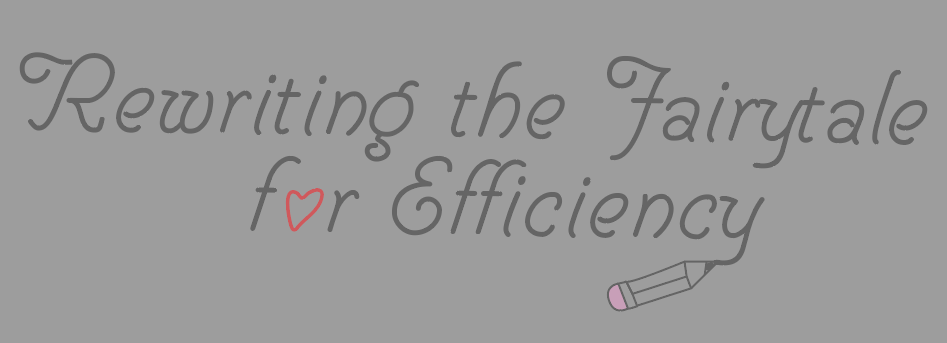
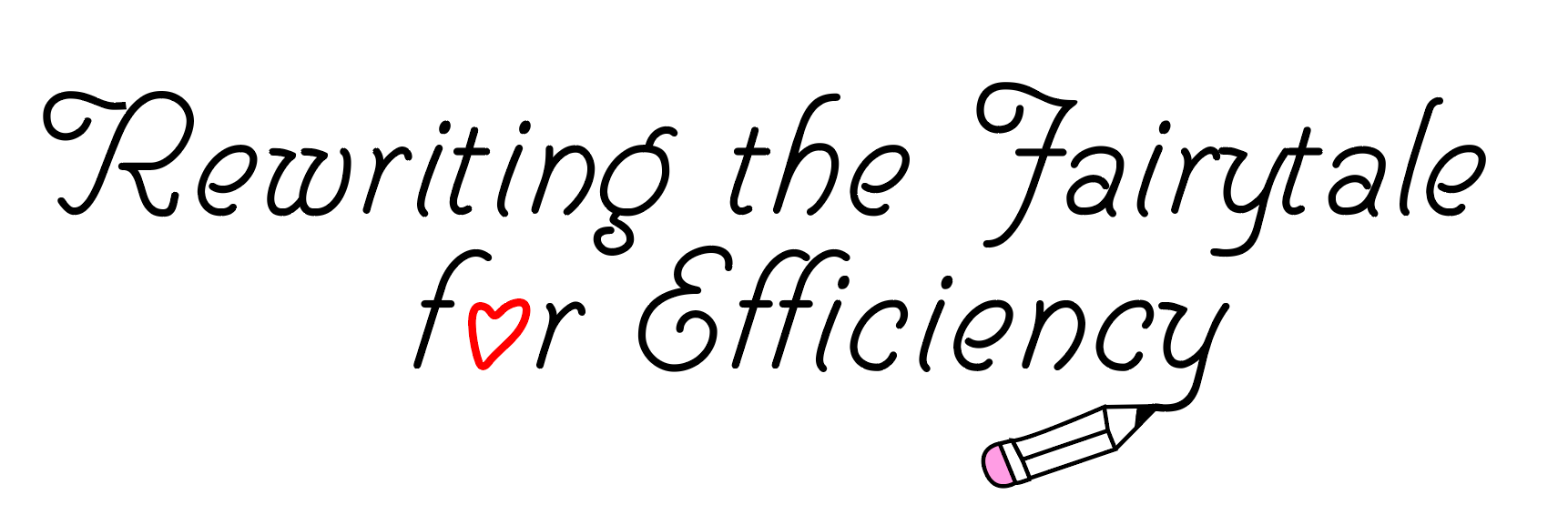 A new survey found an increasing trend: that millennials are having sex with someone before dating them more and more often. Another increasing trend among millennials is to use dating apps to meet people. Correlation is not causation, but the evidence is pretty damning.
A new survey found an increasing trend: that millennials are having sex with someone before dating them more and more often. Another increasing trend among millennials is to use dating apps to meet people. Correlation is not causation, but the evidence is pretty damning.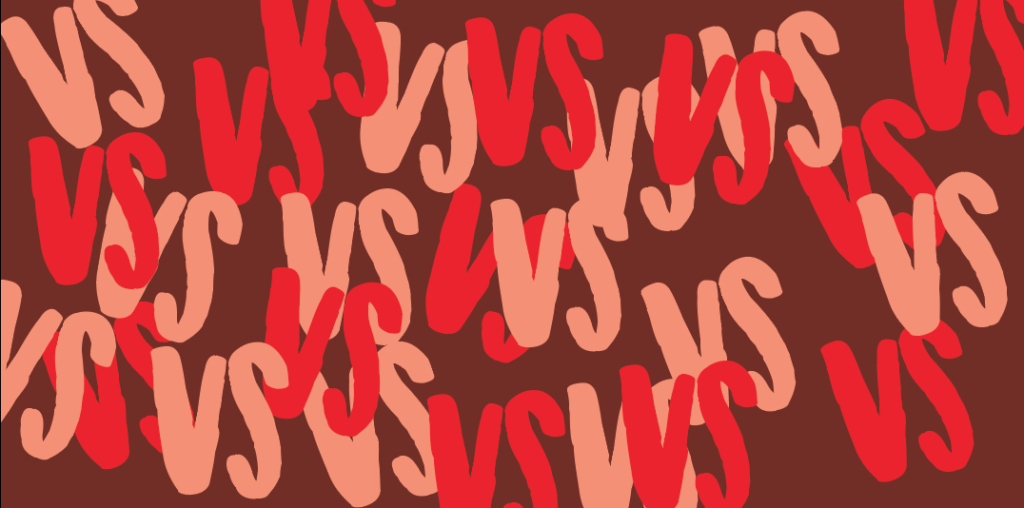
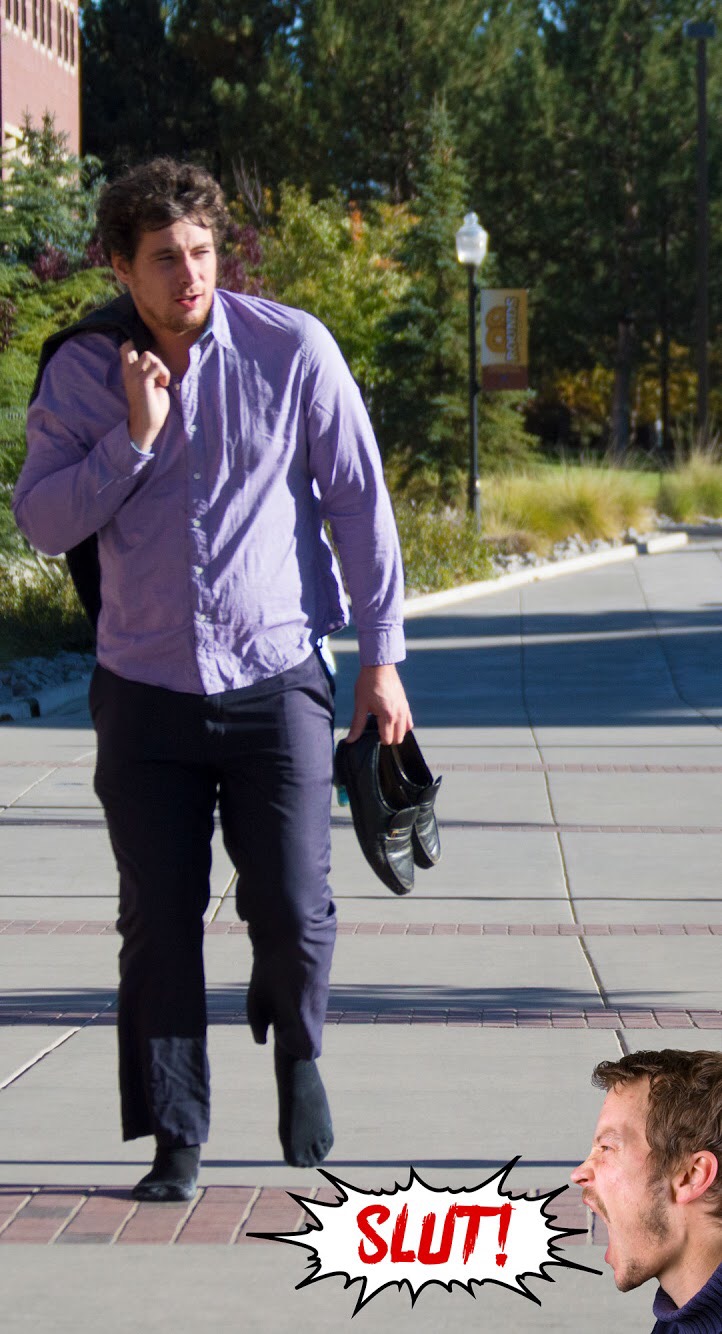 Sexual equality is not gender equality. Sexual equality is the freedom to express yourself and your sexual desires on a healthy, appropriate level just as much as the opposite sex. It’s being able to initiate courtship just because it’s what you want. It’s not being afraid of what people will think of you or your behavior. Sexual equality is being able to freely communicate and act on your sexual desires, so long as it harms no one, without fear of being shunned or outcast. Sexual equality is the idea of treating men and women as equals, whether it’s a long-term, committed relationship, or a casual “hook-up.”
Sexual equality is not gender equality. Sexual equality is the freedom to express yourself and your sexual desires on a healthy, appropriate level just as much as the opposite sex. It’s being able to initiate courtship just because it’s what you want. It’s not being afraid of what people will think of you or your behavior. Sexual equality is being able to freely communicate and act on your sexual desires, so long as it harms no one, without fear of being shunned or outcast. Sexual equality is the idea of treating men and women as equals, whether it’s a long-term, committed relationship, or a casual “hook-up.”